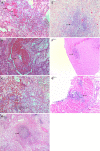Surgical complications in COVID-19 patients in the setting of moderate to severe disease
- PMID: 34512902
- PMCID: PMC8394377
- DOI: 10.4240/wjgs.v13.i8.788
Surgical complications in COVID-19 patients in the setting of moderate to severe disease
Abstract
The coronavirus disease 2019 (COVID-19) pandemic has had a considerable impact on the work of physicians and surgeons. The connection between the patient and the surgeon cannot be replaced by telemedicine. For example, the surgical staff faces more serious difficulties compared to non-surgical specialists during the COVID-19 pandemic. The primary concerns include the safest solutions for protecting healthcare staff and patients and the ability to provide adequate surgical care. Additionally, the adverse effects of any surgery delays and the financial consequences complicate the picture. Therefore, patients' admission during the COVID-19 pandemic should be taken into consideration, as well as preoperative measures. The COVID-19 situation brings particular risk to patients during surgery, where preoperative morbidity and mortality rise in either asymptomatic or symptomatic COVID-19 patients. This review discusses the recent factors associated with surgical complications, mortality rates, outcomes, and experience in COVID-19 surgical patients.
Keywords: Acute respiratory distress syndrome; COVID-19; Mortality rate; SARS-CoV-2; Surgery; Surgery complications; Thrombosis.
©The Author(s) 2021. Published by Baishideng Publishing Group Inc. All rights reserved.
Conflict of interest statement
Conflict-of-interest statement: The authors declare no conflict of interest.
Figures

Similar articles
-
A Reminder of Skin Cancer During the COVID-19 Pandemic.Acta Dermatovenerol Croat. 2021 Apr;291(1):58. Acta Dermatovenerol Croat. 2021. PMID: 34477068
-
Surgical Infection Society Guidance for Operative and Peri-Operative Care of Adult Patients Infected by the Severe Acute Respiratory Syndrome Coronavirus-2 (SARS-CoV-2).Surg Infect (Larchmt). 2020 May;21(4):301-308. doi: 10.1089/sur.2020.101. Epub 2020 Apr 20. Surg Infect (Larchmt). 2020. PMID: 32310715 Review.
-
Anesthetic Complications Associated With Severe Acute Respiratory Syndrome Coronavirus 2 in Pediatric Patients.Anesth Analg. 2021 Aug 1;133(2):483-490. doi: 10.1213/ANE.0000000000005606. Anesth Analg. 2021. PMID: 33886516
-
Diagnostic Delays for Non-melanoma Skin Cancers in Renal Transplant Recipients during the COVID-19 Pandemic: What is Hiding Behind the Mask?Acta Dermatovenerol Croat. 2021 Jul;29(2):111-113. Acta Dermatovenerol Croat. 2021. PMID: 34477079
-
The theoretical mortality risk of an asymptomatic patient with a negative SARS-CoV-2 test developing COVID-19 following elective orthopaedic surgery.Bone Joint J. 2020 Sep;102-B(9):1256-1260. doi: 10.1302/0301-620X.102B9.BJJ-2020-1147.R1. Epub 2020 Jul 6. Bone Joint J. 2020. PMID: 32627569 Review.
Cited by
-
Timing of total joint arthroplasty post-COVID-19: an evaluation of the optimal window to minimize perioperative risks.Arthroplasty. 2024 Oct 4;6(1):53. doi: 10.1186/s42836-024-00275-x. Arthroplasty. 2024. PMID: 39367443 Free PMC article.
-
Postoperative Complications in Patients With the Preoperative COVID-19 Infection at King Fahad Specialist Hospital: A Retrospective Cohort Study.Cureus. 2023 Dec 6;15(12):e50037. doi: 10.7759/cureus.50037. eCollection 2023 Dec. Cureus. 2023. PMID: 38186544 Free PMC article.
-
The impact of immune dysfunction on perioperative complications in surgical COVID-19 patients: an imperative for early immunonutrition.Patient Saf Surg. 2022 Apr 1;16(1):14. doi: 10.1186/s13037-022-00323-y. Patient Saf Surg. 2022. PMID: 35365199 Free PMC article.
-
Assessment of Complications and Length of Hospital Stay Associated With Surgical Emergencies in Patients With Concurrent COVID-19 Infection.Cureus. 2024 Sep 8;16(9):e68965. doi: 10.7759/cureus.68965. eCollection 2024 Sep. Cureus. 2024. PMID: 39385929 Free PMC article.
-
Does coronavirus disease 2019 history alone increase the risk of postoperative pulmonary complications after surgery? Prospective observational study using serology assessment.PLoS One. 2024 May 21;19(5):e0300782. doi: 10.1371/journal.pone.0300782. eCollection 2024. PLoS One. 2024. PMID: 38771760 Free PMC article.
References
Publication types
LinkOut - more resources
Full Text Sources
Miscellaneous

